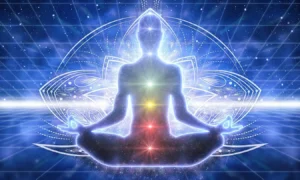What are chakras and how many exist? Title: Understanding Chakras Exploring Ancient Wisdom and Modern Perspectives Chakras, originating from ancient Indian spiritual traditions, are widely regarded as energy centers within the human body. These centers are believed to correspond to different aspects of our physical, emotional, and spiritual well-being. While the concept of chakras may seem esoteric to some, they have garnered significant interest and attention in contemporary wellness practices, blending ancient wisdom with modern approaches to holistic health. Just as the human body is a complex and interconnected system, so too is the natural world. Consider the ecosystem of a forest: each component, from the towering trees to the smallest microorganisms in the soil, plays a crucial role in maintaining balance and vitality. Similarly, chakras are thought to represent different aspects of our being, each contributing to our overall sense of harmony and wellness. Just as disturbances in one part of a forest ecosystem can ripple out and affect the entire system, imbalances in our chakras can impact various aspects of our physical, emotional, and spiritual health. While the existence and functioning of chakras cannot be empirically verified through traditional scientific methods, there is growing interest in exploring their potential significance from a holistic perspective. Some researchers have suggested that the concept of chakras may offer insights into the mind-body connection and the interplay between psychological and physiological processes. For example, a study published in the Journal of Alternative and Complementary Medicine (Bello et al., 2018) explored the effects of mindfulness meditation, which is often associated with chakra balancing, on stress reduction and overall well-being. “Emanate boundless love towards the entire world.” Swami Vivekananda “Find balance within, and you will find balance in all aspects of your life.” Deepak Chopra Chakras are believed to be energy centers located along the spine, each corresponding to specific physical, emotional, and spiritual aspects of human experience. There are typically seven main chakras, aligned from the base of the spine to the crown of the head: Root, Sacral, Solar Plexus, Heart, Throat, Third Eye, and Crown. Each chakra is associated with a particular color, element, mantra, and aspect of consciousness. Imbalances in chakras are thought to manifest as physical ailments, emotional disturbances, or spiritual blockages. Practices such as yoga, meditation, Reiki, and aromatherapy are often used to balance and align the chakras. Sources: Ancient Eastern thought, as exemplified by the concept of chakras, often emphasizes interconnectedness, harmony, and the integration of mind, body, and spirit. It views health and wellness holistically, recognizing the influence of internal energies and external factors on one’s well-being. In contrast, contemporary Western thinking tends to prioritize empirical evidence and reductionist approaches to health, focusing on diagnosing and treating specific symptoms rather than addressing underlying imbalances. However, there is a growing appreciation in Western medicine for the role of holistic practices and mind-body interventions in promoting overall wellness. “Imagine the chakras as lotus flowers emerging from the murky waters of the human consciousness pond. Each flower, from root to crown, represents a chakra, each at different stages of blooming. Just as lotus flowers open towards the sunlight, the chakras awaken and activate as we ascend towards spiritual enlightenment. Like the lotus, which has eight main petals, there are seven main chakras extending from the base of the spine to the top of the head, each symbolizing a unique stage in the journey towards self-realization and connection with the divine.” What is the function of chakras in the human body? Understanding the Function of Chakras in the Human Body Chakras, according to ancient Eastern traditions, are believed to be energy centers within the human body that play a vital role in regulating physical, emotional, and spiritual well-being. Each chakra is associated with specific qualities and functions, and their harmonious alignment is thought to contribute to overall health and vitality. While the concept of chakras may seem abstract, exploring their function can provide valuable insights into the interconnectedness of mind, body, and spirit. Just as a delicate ecosystem relies on the balance and interdependence of its various components to thrive, so too does the human body depend on the harmonious functioning of its chakras. Like the intricate web of life in a forest, where every plant, animal, and organism plays a crucial role in sustaining the ecosystem, each chakra in the human body serves a distinct purpose in maintaining equilibrium and promoting holistic well-being. Just as disruptions in one part of an ecosystem can have ripple effects throughout the entire system, imbalances in the chakras can impact multiple aspects of a person’s health and vitality. While scientific research on chakras is limited, there is growing interest in exploring their potential significance from a holistic perspective. Some studies have suggested a correlation between the practice of techniques like meditation and yoga, which are often associated with chakra balancing, and improvements in mental health and well-being. For example, a meta-analysis published in the Journal of Alternative and Complementary Medicine (Pascoe et al., 2017) found evidence supporting the effectiveness of meditation in reducing symptoms of anxiety and depression. “The body is your temple. Keep it pure and clean for the soul to reside in.” B.K.S. Iyengar “Within you there is a stillness and a sanctuary to which you can retreat at any time and be yourself.” Hermann Hesse Chakras are believed to be energy centers located along the spine, each associated with specific physical, emotional, and spiritual functions. There are seven main chakras, aligned from the base of the spine to the crown of the head: Root, Sacral, Solar Plexus, Heart, Throat, Third Eye, and Crown. Each chakra is associated with a particular color, element, sound, and aspect of consciousness. Imbalances in chakras are thought to manifest as physical ailments, emotional disturbances, or spiritual blockages. Practices such as meditation, yoga, Reiki, and acupuncture are often used to balance and align the chakras. Sources: Ancient Eastern thought, as exemplified by the concept of chakras, emphasizes the interconnectedness of mind, body, and spirit and views













